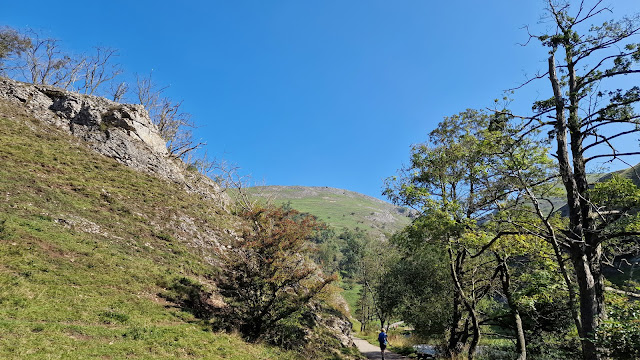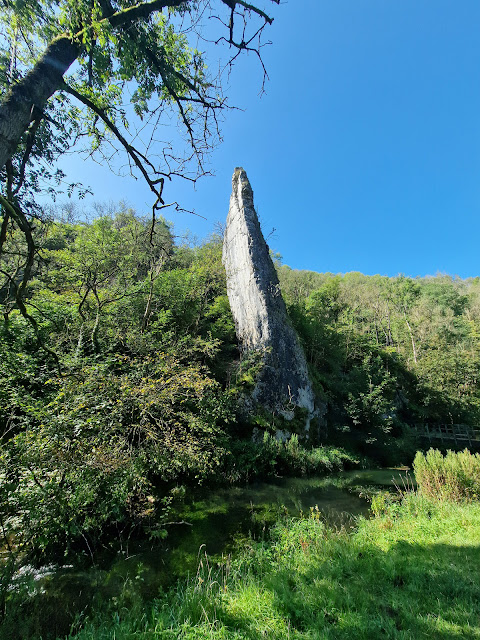A very different post this time from a week long holiday in the Peak District. We had never been before, yes, despite our travels around the world, there are places in this country that have not been visited. We were based in accommodation in Buxton, which was just under a four hour journey from Hampshire. This post will be more about the beautiful places in this, the first National Park set up in this country. Another first was that the weather forecast was looking like it was going to favour us for once.
Our first day out was to the Derwent and Ladybower reservoirs, I had picked a walk that took in both sets of water and walked across the surrounding moors. We had left a little late and when we arrived the car park was full, fortunately we were able to find a space for no fee in one of the off road spaces, not, this place fills up fast and with the glorious weather we should have known.
The walk took us from the main car park around the base of the Derwent reservoir dam and then downhill towards the location of the Derwent village that was flooded when the valley was flooded in the creation of the Ladybower reservoir
We came past a large house that was almost covered in House Martins, there must have been around 200 plus birds on the wires and around the wall of the house. As I said earlier this was a different trip, I didn't have my Canon R7 but was using the small EOS M100. This though gives some idea of the number of birds.
Rather than go on to the remains of the village we followed the route which took us up a steep hill with views to the moor above.
Coming out into the open we paused for breath and shade, it was getting hot. This provided views away across the Ladybower reservoir.
Ladybower was built between 1935 and 1943, and was officially opened by King George VI on 24th September 1945.
Ladybower was a very attractive location for the storage of water, with its long deep valley and narrow points for dam building. This, combined with the high average rainfall, low population level and heavy demand for water from the industrial towns that surrounded the Peak District, made the case for the reservoir to be constructed.
As already mentioned the village of Derwent was flooded, but also the village of Ashopton to create Ladybower Reservoir and the inhabitants were relocated to Yorkshire Bridge estate, just downstream of Ladybower Dam.
As we climbed up above the tree line you could see the changing landscape and colour with fields merging into the heather.
We walked through an area with an interesting name, Grouse Butts, probably an area where grouse shooting took place. Unfortunately I didn't see any grouse, the only birds on show were Meadow Pipits.
The walk then started to head downhill with Derwent Water coming into view.
In World War II, the topographical similarity between the
Upper Derwent Valley and the Ruhr Valley of Germany led to the dams being used
for practice runs for the Lancaster bombers of 617 Squadron (the Dam Busters)
before their attack on the Ruhr dams. The world-famous Dam Busters film was
subsequently filmed here, and the area has seen various commemorative flypasts
by the Battle of Britain Memorial Flight.
The walk down to the reservoir was demanding but once down it was a nice flat path back to the car park and an ice cream. A glorious day with some stunning scenery, a good start.
The next day we were off to Dovedale, another famous location in the Peak District. A beautiful gorge created by the River Dove carving through the limestone.
Another beautiful day, we decided to arrive a little earlier and the car park was not that busy. We set off along the path toward the Stepping Stones a series of steps that cross the river as it bends into the gorge.
I had hoped we would see a Dipper as I haven't seen one yet this year and one obliged close to the path as we left the car park.
We crossed the river tat the Stepping Stones to walk the main path on the other side.
A view of the other side, it looks wonderful in the morning light, believe me when we returned this place was heaving with humanity!
Another sad thing was the amount of litter that we could see, National Trust rangers were present picking up the rubbish people had left behind.
As we walked away from the Stepping Stones the number of persons about reduced quickly and we began to see some wildlife. Grey Wagtails flitting around the stones and branches.
And more Dippers some of which were singing which was something I have never heard before.
One particular stack is known as Ilam Rock, named after the village and park nearby.
We walked on knowing we would have to turn back and retrace our steps to the car. We did so after a short rest. Another Dipper singing had us searching until I found it right below us on the river.
We had passed Dovehole Caves on the way but they were busy with people, one the way back we had them to ourselves.
Quite impressive with not much depth but quite a bit of height.
Some lovely views as we made our way back.
There were so many people at the Stepping Stones we quickly made our way back to the car park, the glorious weather and maybe schools still closed had really brought them out. We had lunch in Ashbourne, then made our way back to Buxton.
The weather was much the same on the following day and we headed of in a north westerly direction up and over the moors with views across toward Manchester. We were off to Lyme Park, a National Trust property that was the location for the filming of the famous scene from the BBC's series of Jane Austen's Pride and Prejudice way back in the early nineties.
Lyme was once home to the Legh family and, in its heyday a
great sporting estate. The 1,400 acre
estate with its medieval herd of red deer offers fantastic walks and stunning
views.
After the gardens we walked through the house with its impressive art collections and tapestries. We then decided to head out on the many trails around the grounds, passing grazing cattle.
Views across to Manchester.
We had seen signs to Darcy's Pond, but had struggled to find it, eventually we came across a small copse with a fence around it and in the middle a pond. This apparently was the pond Colin Firth dived in and swam before making his way with his horse down towards the house and to eventually meet Miss Bennett.
Would the weather continue for a visit to Chatsworth, well it did, but with some mist and low cloud around as we headed towards Bakewell, this quickly burnt off as we arrived. Originally we had booked for the gardens only, but upgraded this to include the house which was a good decision.
The seat of the Duke of Devonshire, it has belonged to
the Cavendish family since 1549. It stands on the east bank of
the River Derwent, across from hills between the Derwent and Wye valleys,
amid parkland backed by wooded hills that rise to heather moorland. The house
holds major collections of paintings, furniture, Old Master drawings, neoclassical
sculptures and books. Chosen several times as Britain's favourite country
house, it is a Grade I listed property from the 17th century, altered in the
18th and 19th centuries. In 2011–2012 it underwent a £14-million
restoration.
After a very interesting tour, we came out into the magnificent gardens and strolled through the paths, taking in the majesty of the house.
I first came across the house when it was used in the ITV series of Brideshead Revisited back in 1981, 42 years later I was finally able to see it. Capability Brown was involved in the surrounding grounds and the gardens.



















































No comments:
Post a Comment